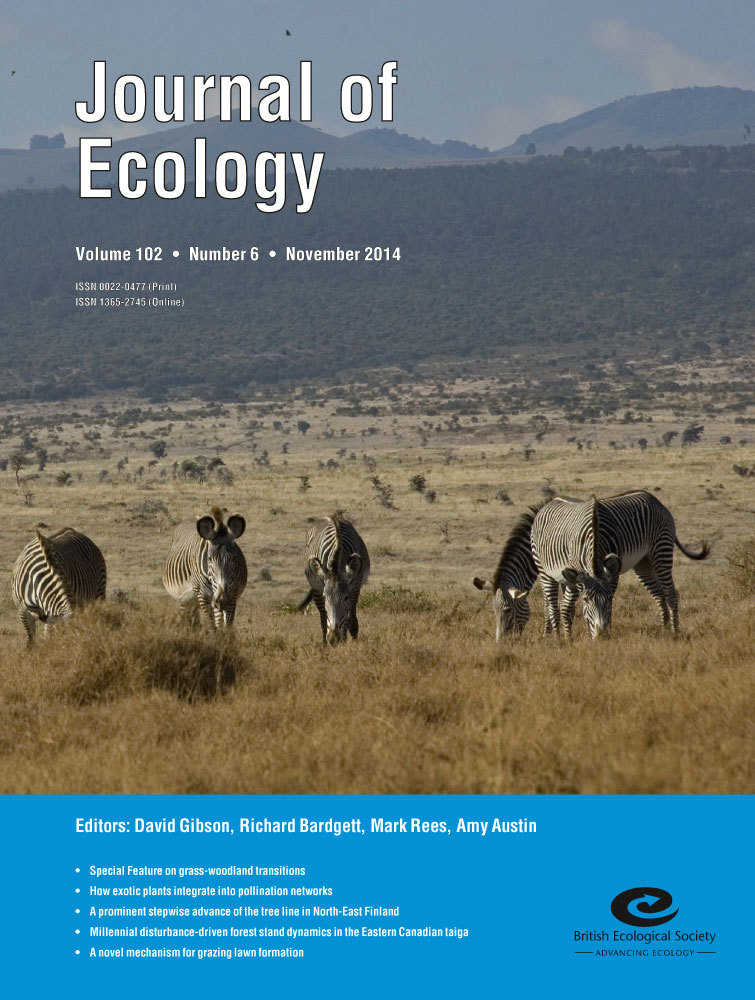View Item
- xmlui.general.dspace_homeCentros Regionales y EEAsCentro Regional Patagonia SurEEA Santa CruzArtículos científicosxmlui.ArtifactBrowser.ItemViewer.trail
- DSpace Home
- Centros Regionales y EEAs
- Centro Regional Patagonia Sur
- EEA Santa Cruz
- Artículos científicos
- View Item
Carbon isotopic signatures of soil organic matter correlate with leaf area index across woody biomes
Abstract
Leaf area index (LAI), a measure of canopy density, is a key variable for modelling and understanding primary productivity, and also water use and energy exchange in forest ecosystems. However, LAI varies considerably with phenology and disturbance patterns, so alternative approaches to quantifying stand‐level processes should be considered. The carbon isotope composition of soil organic matter (δ13CSOM) provides a time‐integrated, productivity‐weighted
[ver mas...]
Leaf area index (LAI), a measure of canopy density, is a key variable for modelling and understanding primary productivity, and also water use and energy exchange in forest ecosystems. However, LAI varies considerably with phenology and disturbance patterns, so alternative approaches to quantifying stand‐level processes should be considered. The carbon isotope composition of soil organic matter (δ13CSOM) provides a time‐integrated, productivity‐weighted measure of physiological and stand‐level processes, reflecting biomass deposition from seasonal to decadal time scales.
Our primary aim was to explore how well LAI correlates with δ13CSOM across biomes.
Using a global data set spanning large environmental gradients in tropical, temperate and boreal forest and woodland, we assess the strength of the correlation between LAI and δ13CSOM; we also assess climatic variables derived from the WorldClim database.
We found that LAI was strongly correlated with δ13CSOM, but was also correlated with Mean Temperature of the Wettest Quarter, Mean Precipitation of Warmest Quarter and Annual Solar Radiation across and within biomes.
Synthesis. Our results demonstrate that δ13CSOM values can provide spatially explicit estimates of leaf area index (LAI) and could therefore serve as a surrogate for productivity and water use. While δ13CSOM has traditionally been used to reconstruct the relative abundance of C3 versus C4 species, the results of this study demonstrate that within stable C3‐ or C4‐dominated biomes, δ13CSOM can provide additional insights. The fact that LAI is strongly correlated to δ13CSOM may allow for a more nuanced interpretation of ecosystem properties of palaeoecosystems based on palaeosol 13C values.
[Cerrar]

Author
Ladd, Brenton;
Peri, Pablo Luis;
Pepper, David A.;
Silva, Lucas C.R.;
Sheil, Douglas;
Bonser, Stephen P.;
Laffan, Shawn W.;
Amelung, Wulf;
Ekblad, Alf;
Eliasson, Peter;
Bahamonde, Héctor Alejandro;
Duarte Guardia, Sandra;
Bird, Michael I.;
Fuente
Journal of Ecology 102 (6) : 1606-1611 (November 2014)
Date
2014-11
Editorial
Wiley
ISSN
0022-0477
1365-2745
1365-2745
Formato
pdf
Tipo de documento
artículo
Palabras Claves
Derechos de acceso
Abierto
 Excepto donde se diga explicitamente, este item se publica bajo la siguiente descripción: Creative Commons Attribution-NonCommercial-ShareAlike 2.5 Unported (CC BY-NC-SA 2.5)
Excepto donde se diga explicitamente, este item se publica bajo la siguiente descripción: Creative Commons Attribution-NonCommercial-ShareAlike 2.5 Unported (CC BY-NC-SA 2.5)


